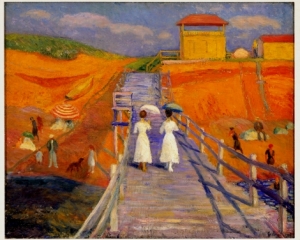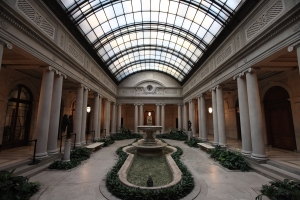|
Displaying items by tag: Metropolitan Museum of Art
A seven-day schedule implemented last year at the Museum of Modern Art (MoMA) and the Metropolitan Museum of Art brought a 7% increase in attendance at the former but no change at the latter, Crain’s New York reported. MoMA started admitting visitors on Tuesdays beginning May 1, 2013; the Met’s transition from six to seven days took place two months later, in July.
A spokesman for the Met told Crain’s that the flat figures were caused by an “unusually harsh winter” along with ongoing construction, begun in late 2013, on the museum’s entrance plaza.

From July 20 through October 13, the Parrish Art Museum presents William Glackens—the first comprehensive survey of the artist’s work since 1966. The exhibition spans Glackens’s career from the 1890s through the 1930s, with more than 70 important paintings and works on paper from some of America's finest private and public collections, including the Metropolitan Museum of Art, Fine Arts Museum of San Francisco, the National Gallery of Art, and the Cleveland Museum, among others. Several works in the exhibition are on view to the public for the first time since 1966.
William Glackens, co-organized and presented by the Parrish Art Museum; Nova Southeastern University Museum of Art | Fort Lauderdale (where it was on view earlier this year); and the Barnes Foundation, Philadelphia (where the exhibition will also travel), spans the full career of the artist, who painted on Long Island from 1911–1915. Curated by writer and art historian Avis Berman, the exhibition focuses on Glackens’s most distinctive and adventurous works.
The Metropolitan Museum of Art in New York is beefing up its glass collection with a gift of 44 works by the Italian architect Carlo Scarpa from the collection of David Landau and his wife Marie-Rose Kahane. The donation is expected to have a “transformative impact on our holdings of 20th-century glass and design”, says Sheena Wagstaff, the museum’s chairman of modern and contemporary art, in a statement.
Scarpa created the objects during his 15-year collaboration with Venini Glassworks in Venice between 1932 and 1947. Together, the architect and Paolo Venini, the founder of the glass company, modernised glassblowing and pioneered innovations in color, form and technique. The 44 works from the Landau and Kahane collection made their US debut earlier this year in the Met’s exhibition “Venetian Glass by Carlo Scarpa: The Venini Company, 1932-1947.”

It’s time again to thank Messrs. Carnegie, Frick, Warburg, Vanderbilt, Morgan & Co. The plutocrats of the last Gilded Age left us unfathomable architectural treasures that we cherish and fight over but are still not sure how to care for. They erected houses, museums, and libraries in the form of temples and Renaissance palazzos, great hunks of ornate stone, carved wood, and intricate parquet, anthologies of precious materials and medieval craft. Some have been lost; touch what’s left and we get angry, alter them and we despair. As Manhattan keeps remaking itself, one shuttered shoe-repair store and vanished brownstone at a time, these ornate piles endure—the Frick, the Cooper Hewitt, the Public Library, the Metropolitan Museum, each with its tribe of passionate loyalists.
None of them is pristine. From the beginning, they experienced decades of fitful renovation, and their occupants still keep bursting through walls. There’s never enough space. Some institutions wear their history more lightly, or have the luxury of starting fresh.
An important, elaborately carved Roman urn of the first-early second century A.D.—one of the finest porphyry vessels to have survived from classical antiquity—has been acquired by The Metropolitan Museum of Art.
The acquisition was made possible in part thanks to a challenge grant from Metropolitan Museum Trustee Mary Jaharis.
Thomas P. Campbell, Director and CEO of the Museum, stated: “This rare and beautiful vase is a superb example of classical craftsmanship at its best. The public will now have the extraordinary opportunity to see it within the context of other Hellenistic and Roman works in various media, and especially other sculptures made of porphyry, in the collection of the Museum’s Department of Greek and Roman Art, one of the major repositories of classical art in North America.”
On June 27, the Metropolitan Museum of Art in New York will present the exhibition “Garry Winogrand,” the first retrospective of the pioneering American photographer’s work in 25 years. Widely regarded as one of the most important photographers of the 20th century, Winogrand captured moments of everyday American life in the postwar era. He produced much of his best-known work in New York City during the 1960s, becoming a major voice of the tumultuous decade.
Known for his energy, honesty, and sense of humor, Winogrand shot business moguls, politicians, hippies, athletes, famous actors, and everyday people on the street, at rodeos, in airports, and at antiwar demonstrations. He traveled from his native New York to San Francisco, Dallas, Houston, Chicago, and the Southwest, creating an expansive visual catalogue of America’s rapidly changing social scene.
On June 30, Sol LeWitt’s “Wall Drawing #370: Ten Geometric Figures (including right triangle, cross, X, diamond) with three-inch parallel bands of lines in two directions” (1982) will go on view at the Metropolitan Museum of Art in New York. The linear, black-and-white drawing will take five drafters four weeks to install.
LeWitt, a founder of both Conceptualism and Minimalism, made his first wall drawing in 1968. The process involved creating guidelines or diagrams so that the two-dimensional works could be drawn directly on a wall using everything from graphite and crayon to India ink and acrylic paint. LeWitt’s wall drawings were designed for limited duration and maximum flexibility within a broad range of architectural settings. Painstakingly executed by drafters, most of LeWitt’s wall drawings were eventually destroyed. “Wall Drawing #370” will be painted over when the exhibition ends on September 7, 2015.
Christie’s auction house says science has confirmed that a disputed painting is the work of Dutch master Johannes Vermeer. The painting could fetch 8 million pounds ($13 million) when it is sold next month.
“Saint Praxedis” is believed to be the earliest surviving work by the 17th-century artist, but there has long been a question mark over its authenticity.
The work was tentatively attributed to Vermeer after it appeared in an exhibition at New York’s Metropolitan Museum in 1969, and the authorship was reinforced in 1986, when leading Vermeer scholar Arthur Wheelock argued it was authentic.
Cambodia on Tuesday officially welcomed the return of three ancient statues looted from the kingdom more than 40 years ago, including one retrieved after a long legal battle in the United States.
Authorities say the 10th-century sandstone artworks were stolen in the 1970s as the country was gripped by civil war, from the Koh Ker temple site near the famed Angkor Wat complex.
The statues, part of a nine-strong ensemble, depict warriors "Duryodhana" and "Bhima" locked in combat -- as well as a bystander called "Balarama".
A painting, which Spanish tax authorities claimed was Van Gogh’s Cypress, Sky and Country (1889), is in fact a terrible fake according to Alfred Weidinger, vice director of Vienna’s Belvedere. The painting was discovered during a raid of safe deposit boxes in Madrid. Speaking to Austrian daily, Die Presse, Weidinger says, “It is one of the worst fakes or, better yet, copies, that I have ever seen. An amateur must have done it based on a calendar shot of the original.”
According to Weidinger, that original from Van Gogh’s Cypress series was indeed painted in 1889 but hangs in New York’s Metropolitan Museum. He says that he spoke with an expert from the Van Gogh museum in Amsterdam who was similarly shocked at just how bad the painting appears to be.
|
|
|
|
|